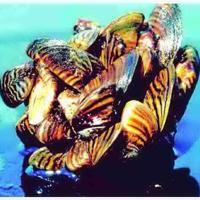HAMILTON — According to Montana Fish, Wildlife and Parks officials, cleaning fishing equipment with hot water could potentially save Montana millions of dollars.
Tayler Templin, Northwest Area AIS supervisor for Montana Fish, Wildlife and Parks, recently gave a presentation to area residents on the risks of invasive species and ways to prevent unintentionally aiding in their spread at a meeting hosted by Bitterroot Trout Unlimited.
“There’s significant activity regarding AIS at the regional level,” Templin explained. “In 2023, mussels were detected in the Snake River for the first time, marking the first detection of mussels in the Columbia River basin.”
In September 2023, a few quagga mussels were found in the Snake River, as reported by the Idaho State Department of Agriculture. Mussels are a major concern for Montana Fish, Wildlife and Parks due to their resilience and ability to spread rapidly.
People are also reading…
“Mussels are a significant issue,” Templin emphasized. “They are often considered the poster child for AIS, and that’s where much of our focus lies.”
Quagga and zebra mussels pose a serious threat as invasive species due to their ability to form large populations that can quickly spread across lake beds, causing ecological imbalances and clogging water intakes.
“Preventing mussels from entering our waters is crucial because our current programs cost $3 million annually,” Templin stated. “If mussels were to establish in Montana waters, the cost could skyrocket to $26 million per year for mitigation efforts.”
Invasive mussel species like quagga and zebra have already invaded multiple large water bodies in the U.S.
Zebra mussels, originally from Ukraine, spread to the Great Lakes in the 1980s by hitchhiking on European ships’ hulls, as reported by USGS.
After establishing a presence in the Great Lakes, zebra mussels quickly expanded their range to the eastern Mississippi River and states like Utah, Texas, California, Nevada, and Colorado.
“In Montana, we often find mussels on boats returning from areas like Lake Havasu, Lake Powell, and the Great Lakes,” Templin noted.
Templin oversees Montana Fish, Wildlife and Parks’ watercraft inspection stations across the state, aiming to intercept contaminated boats before they spread invasive species.
For Montanans planning to transport boats to and from out-of-state waters, Templin recommended renting a boat instead to avoid potential contamination issues.
“Renting a boat is a much simpler solution in the long run,” Templin advised. “Returning to Montana with mussels on a boat typically results in a minimum 30-day quarantine, which can extend up to two months.”
Another key step individuals can take to prevent the spread of AIS, such as the New Zealand mud snail, is to thoroughly sanitize their equipment between uses, Templin stressed.
“It is essential for everyone to clean, drain, and dry their equipment after each use,” Templin emphasized. “Repetition of the message ‘clean, drain, dry’ is critical to prevent spreading invasive species.”
The New Zealand mud snail, a highly invasive aquatic species, was discovered in a private hatchery in the Bitterroot region within the last five years. These small snails reproduce rapidly, with one snail producing around 230 offspring annually.
“Simple actions like rinsing off waders or boots can help prevent the spread of species like mud snails,” Templin added.
Mussels, mud snails, and other invasive species can be removed from equipment using hot water, as per Templin’s recommendation.
“Our department solely relies on hot water for sanitation, without the use of chemicals, at temperatures ranging from 120 to 140 degrees,” Templin stated.
Additional sanitation guidelines from the Pennsylvania Fish and Boat Commission include freezing gear for at least six hours, soaking gear in water above 120 degrees Fahrenheit for at least five minutes, and fully drying gear for a minimum of five days.
Templin emphasized the ongoing threat of AIS and urged Montanans to actively protect and preserve their water resources.
“The potential for AIS is always present, so it is crucial for everyone to clean, drain, and dry before moving between water bodies,” Templin concluded.





